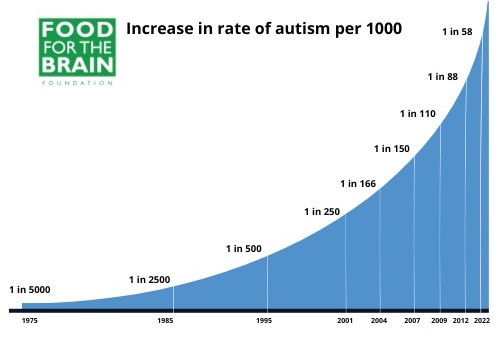
The number of children diagnosed with ADHD, autism and other neurodevelopmental disorders classifying them as ‘neurodivergent’, has rocketed in both the UK and US.
“Now, one in six children in the US are classified as neurodivergent and one in 36 as autistic – a fourfold increase in 20 years[i].” says paediatric Professor Alessio Fasano from Massachusetts General Hospital for Children, Harvard Medical School.
Similar figures are being reported in the UK. According to Dr Rona Tutt OBE, past president of the National Association of Head teachers “There has been a dramatic increase in the number of people being diagnosed with ASD. Although some of this is due to a broader definition of autism as well as better diagnosis, it raises the question of whether it may also be the result of environmental changes, which have also been dramatic.”
Some UK schools are reporting as many as one in four children having problems.
Autistic spectrum disorders (ASD) are often considered largely to be genetically linked. However, since the genes cannot have changed this rapidly, the increase points to the influence of environmental factors.
A team of world experts is presenting a ‘New Frontiers in Autism Masterclass’ in London on June 21st to explore what’s going wrong and how to help children and parents.
Professor Michael Crawford, who heads the Institute of Brain Chemistry and Human Nutrition at the Chelsea & Westminster Hospital says “We can predict which babies are going to have developmental problems from the fats in the mother’s blood. When omega-3 levels are low, the mother produces a non-functional ‘brain fatThere are many different types of fats; polyunsaturated, monounsaturated, hydrogenated, saturated and trans fat. The body requires good fats (polyunsaturated and monounsaturated) in order to… substitute’ to build their baby’s brain during pregnancy, high levels of which predict problems. The brain is 50% fat, and omega-3 DHADHA is short for Docosahexaenoic Acid. It is an essential omega-3 fatty acid found in fish such as salmon, mackerel and herring, and is often… should make up most of the structural fat in brain cells.” Less than 5 per cent of children in the UK achieve the basic dietary recommendations for omega-3 and fish.[ii]
Dr Fasano thinks something is going wrong in the gut, with many ASD children reporting gut problems including diarrhoea, constipation, belching and excessive flatulence and ‘dysbiosis’ – abnormal patterns of gut bacteria. In some children, wheat and milk may contribute to these symptoms. His research finds that neurodivergent children show high levels of ‘zonulin’, a family of proteins that regulate the barrier between intestinal cells in the digestive tract that can lead to “leaky gut.”.[iii] ASD children are often found to have opioid-like wheat and milk proteins in their urine, making these foods especially ‘addictive’.
Vitamins may help. A high level of homocysteineHomocysteine is an amino acid found in the blood. Elevated levels of homocysteine have been associated with narrowing and hardening of the arteries, an increased…, a marker for B vitamin deficiency, predicts ASD and studies giving homocysteine-lowering vitamin B6, B12 and folate help reduce symptoms. Vitamin A improves eye coordination and vision, helping those with autism who don’t look you in the eye and have visual problems.
A 12-month randomised controlled trial giving omega-3, vitamins, digestive enzymesDigestive enzymes break down carbohydrates, fats and proteins into their smallest components, allowing them to be absorbed by the body. Examples of digestive enzymes include…, and a healthy gluten-free, casein-free diet showed major improvement in both autistic symptoms and raising IQ.[iv]
Nutrition and functional medicine therapist Anne Pemberton, who specialises in helping those with ASD reports considerable success, not just by improving nutrition but by addressing the psychological and social circumstances of neuro-divergent children. “It is critical to work with both mother and child, and not only address critical nutritional issues, stress triggers including early life traumas, and suppressed emotions as a result of their condition and conditioning, and to help them develop a sense of self and mindset. I have seen hundreds of children and adults who usually have major improvements. Peter, age 8, is a case in point. He was diagnosed with ASD and classified as needing special education. 15 months later he’s no longer even classified as ASD.”
On June 21st the charitable Food for the Brain Foundation are hosting an on-line Masterclass with all these experts.
To find out more and to book – foodforthebrain.org/autismmasterclass
References
Source of graph: https://www.cdc.gov/ncbddd/autism/data.html
[i] https://www.cdc.gov/ncbddd/autism/data.html
[ii] Kranz S et al, Nutrients. 2017 doi: 10.3390/nu9040392.
[iii] Asbjornsdottir B et al Nutrients. 2020 doi: 10.3390/nu12071982.
[iv] Adams JB et al, Nutrients. 2018 doi: 10.3390/nu10030369.

Comments
Join the Conversation on our Facebook Page